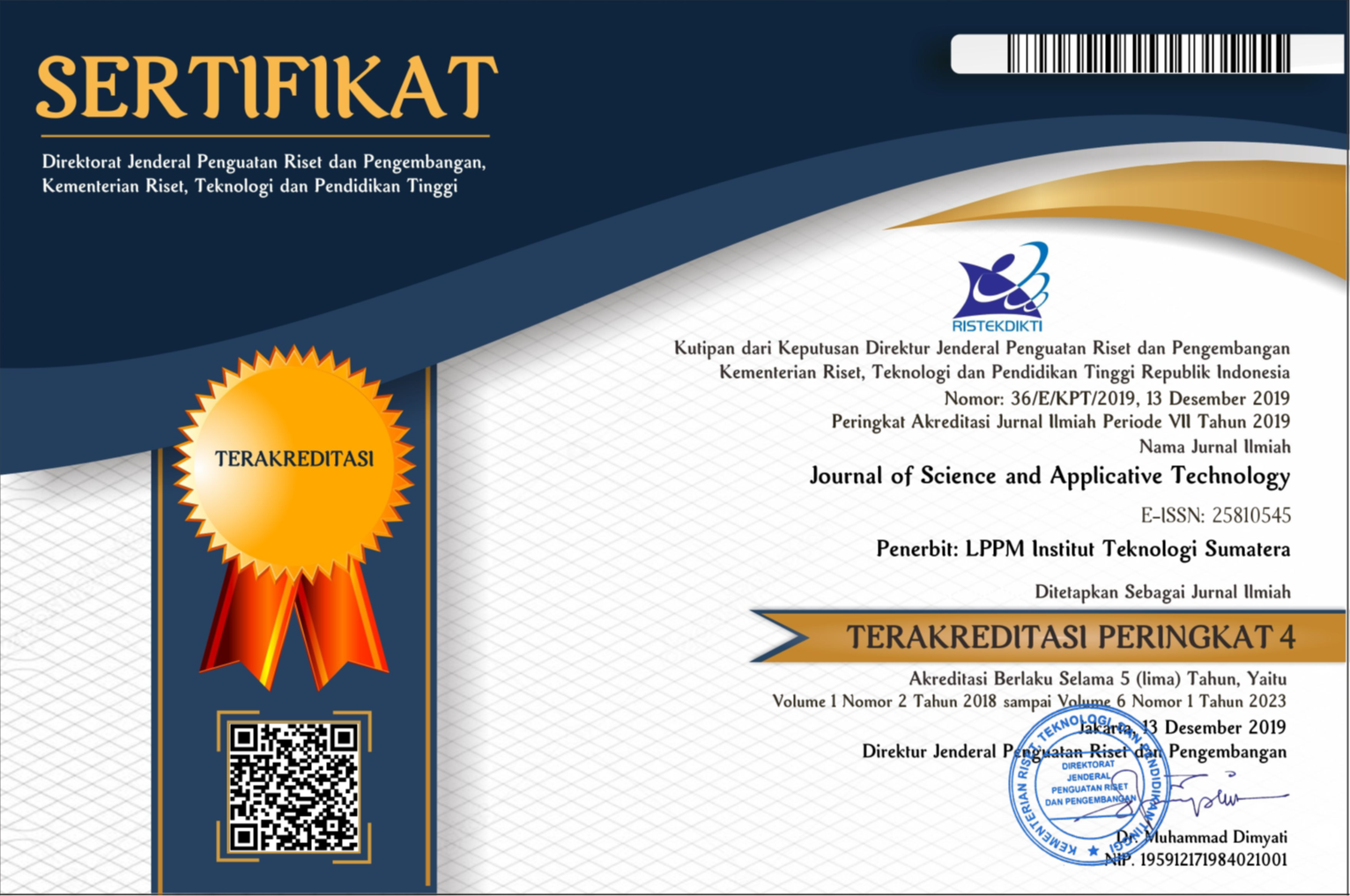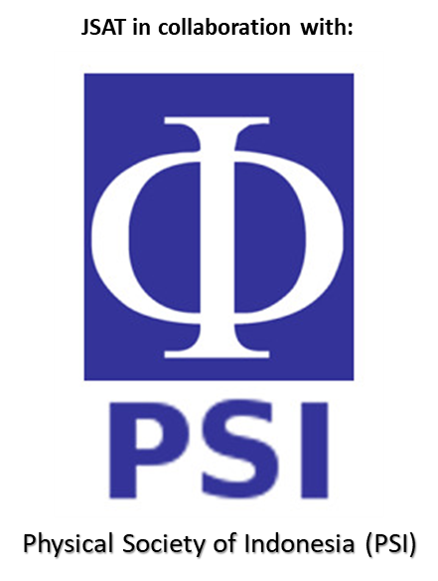Predicting Multi-Epitope Peptide Cancer Vaccine from Novel TAA Topo48
Abstract
Cancer is one of the most lethal diseases. Recently, cancer immunotherapy has a tremendous achievement in cancer treatment. A certain number of cancer based epitope vaccines with different moiety have been discovered. In japan, several clinical tests of cancer based epitope vaccine derived from tumor associated antigens (TAAs) are now ongoing or have recently been completed. a novel of TAAs potentially as cancer vaccine have been retrieved from a fragment weighed 48kDa derived from human DNA-topoisomerase 1 (TOP1) called Topo48. Therefore, it is still critical to discover a derived Topo48 epitope based cancer vaccine. Immuno-informatics considered as a methods noted to have better accuracy to design promising vaccine candidates. Here, continuous and discontinuous B-cell epitopes following with CTL epitopes and their docking interaction to major histocompatibility complex (MHC) class I Human Leukocyte Antigens (HLA)- A0201 were predicted. Kolaskar-Tongaonkar’s, Emini’s, Karpus-Schulz’s, and Parker’s methods were used to predict continuous B-cell epitopes while ElliPro was used for prediction of discontinued B-cell epitopes. Those considered methods marked to have better accuracy to design promising vaccine candidates. Similarly, CTL epitopes was also predicted by using NetCTL server and the best candidates were further investigated their binding affinity by mean of PEP-FOLD3, PatchDock rigid-body docking server, and FireDock server. Total 27 continuous epitopes and 7 discontinuous B-cell epitopes were predicted. In the other hand, 9 peptides were predicted as CTL epitopes. Whereas, three predicted CTL epitope in range 263MLDHEYTTK27, 755AIDMADEDY763, 715ALGTSKLNY724) exhibited good interactions to HLA-A0201. Moreover, we also found residues His266, Thr270, Ala755, Tyr723, Thr718, Ser719, Lys720 from Topo48 and residues Thr163, Asp757, His70, Glu63 from HLA- A0201 were indicated to be antigenic. Ultimately, our proposed continuous/discontinuous B-cell epitopes, and also CTL epitopes can be potential vaccines for cancer immunotherapy.
Downloads
References
[2] D. Laheru and E. M. Jaffee, “Cancer Vaccines,†The Cancer Handbook. 15-Oct-2007.
[3] I. Mellman, G. Coukos, and G. Dranoff, “Cancer immunotherapy comes of age.,†Nature, vol. 480, no. 7378, pp. 480–489, Dec. 2011.
[4] D. T. Nair, K. Singh, Z. Siddiqui, B. P. Nayak, K. V. S. Rao, and D. M. Salunke, “Epitope recognition by diverse antibodies suggests conformational convergence in an antibody response.,†J. Immunol., vol. 168, no. 5, pp. 2371–2382, Mar. 2002.
[5] J. Huang and W. Honda, “CED: a conformational epitope database.,†BMC Immunol., vol. 7, p. 7, Apr. 2006.
[6] I. Espinoza-Delgado, “Cancer vaccines.,†Oncologist, vol. 7 Suppl 3, pp. 20–33, 2002.
[7] S. Krishna and K. S. Anderson, “T-Cell Epitope Discovery for Therapeutic Cancer Vaccines.,†Methods Mol. Biol., vol. 1403, pp. 779–796, 2016.
[8] Y. Nishimura, Y. Tomita, A. Yuno, Y. Yoshitake, and M. Shinohara, “Cancer immunotherapy using novel tumor-associated antigenic peptides identified by genome-wide cDNA microarray analyses,†Cancer Sci., vol. 106, no. 5, pp. 505–511, May 2015.
[9] Y. Kametani, A. Miyamoto, B. Tsuda, and Y. Tokuda, “B Cell Epitope-Based Vaccination Therapy,†Antibodies , vol. 4, no. 3. 2015.
[10] M. A. Cheever et al., “The prioritization of cancer antigens: a national cancer institute pilot project for the acceleration of translational research.,†Clin. cancer Res. an Off. J. Am. Assoc. Cancer Res., vol. 15, no. 17, pp. 5323–5337, Sep. 2009.
[11] B. Tsuda et al., “Abstract P5-01-11: A new anti-HER2 peptide ‘CH401MAP’ can stimulate the immunity of breast cancer patients,†Cancer Res., vol. 73, no. 24 Supplement, pp. P5-01-11 LP-P5-01–11, Dec. 2013.
[12] G. Suntharalingam et al., “Cytokine storm in a phase 1 trial of the anti-CD28 monoclonal antibody TGN1412.,†N. Engl. J. Med., vol. 355, no. 10, pp. 1018–1028, Sep. 2006.
[13] V. Brusic and N. Petrovsky, “Immunoinformatics and its relevance to understanding human immune disease.,†Expert Rev. Clin. Immunol., vol. 1, no. 1, pp. 145–157, May 2005.
[14] N. Tomar and R. K. De, “Immunoinformatics: an integrated scenario,†Immunology, vol. 131, no. 2, pp. 153–168, Oct. 2010.
[15] M. N. Davies and D. R. Flower, “Harnessing bioinformatics to discover new vaccines.,†Drug Discov. Today, vol. 12, no. 9–10, pp. 389–395, May 2007.
[16] A. S. Kolaskar and P. C. Tongaonkar, “A semi-empirical method for prediction of antigenic determinants on protein antigens.,†FEBS Lett., vol. 276, no. 1–2, pp. 172–174, Dec. 1990.
[17] E. A. Emini, J. V Hughes, D. S. Perlow, and J. Boger, “Induction of hepatitis A virus-neutralizing antibody by a virus-specific synthetic peptide,†J. Virol., vol. 55, no. 3, pp. 836–839, Sep. 1985.
[18] P. A. Karplus and G. E. Schulz, “Prediction of chain flexibility in proteins,†Naturwissenschaften, vol. 72, no. 4, pp. 212–213, 1985.
[19] J. M. Parker, D. Guo, and R. S. Hodges, “New hydrophilicity scale derived from high-performance liquid chromatography peptide retention data: correlation of predicted surface residues with antigenicity and X-ray-derived accessible sites.,†Biochemistry, vol. 25, no. 19, pp. 5425–5432, Sep. 1986.
[20] A. Patronov and I. Doytchinova, “T-cell epitope vaccine design by immunoinformatics,†Open Biol., vol. 3, no. 1, p. 120139, Jan. 2013.
[21] S. Yie et al., “A protein fragment derived from DNA-topoisomerase I as a novel tumour-associated antigen for the detection of early stage carcinoma,†Br. J. Cancer, vol. 115, no. 12, pp. 1555–1564, 2016.
[22] A. Boonsong, S. Curran, J. A. McKay, J. Cassidy, G. I. Murray, and H. L. McLeod, “Topoisomerase I protein expression in primary colorectal cancer and lymph node metastases.,†Hum. Pathol., vol. 33, no. 11, pp. 1114–1119, Nov. 2002.
[23] R. A. Laskowski, M. W. MacArthur, D. S. Moss, and J. M. Thornton, “PROCHECK: a program to check the stereochemical quality of protein structures,†J. Appl. Crystallogr., vol. 26, no. 2, pp. 283–291, 1993.
[24] J. Ponomarenko et al., “ElliPro: a new structure-based tool for the prediction of antibody epitopes.,†BMC Bioinformatics, vol. 9, p. 514, Dec. 2008.
[25] M. V Larsen, C. Lundegaard, K. Lamberth, S. Buus, O. Lund, and M. Nielsen, “Large-scale validation of methods for cytotoxic T-lymphocyte epitope prediction.,†BMC Bioinformatics, vol. 8, p. 424, Oct. 2007.
[26] A. Lamiable, P. Thévenet, J. Rey, M. Vavrusa, P. Derreumaux, and P. Tufféry, “PEP-FOLD3: faster de novo structure prediction for linear peptides in solution and in complex.,†Nucleic Acids Res., vol. 44, no. W1, pp. W449-54, Jul. 2016.
[27] O. Y. Borbulevych et al., “T cell receptor cross-reactivity directed by antigen-dependent tuning of peptide-MHC molecular flexibility,†Immunity, vol. 31, no. 6, pp. 885–896, Dec. 2009.
[28] D. Schneidman-Duhovny, Y. Inbar, R. Nussinov, and H. J. Wolfson, “Geometry-based flexible and symmetric protein docking,†Proteins, vol. 60, no. 2, pp. 224–231, 2005.
[29] N. Andrusier, R. Nussinov, and H. J. Wolfson, “FireDock: fast interaction refinement in molecular docking.,†Proteins, vol. 69, no. 1, pp. 139–159, Oct. 2007.
[30] E. F. Pettersen et al., “UCSF Chimera--a visualization system for exploratory research and analysis.,†J. Comput. Chem., vol. 25, no. 13, pp. 1605–1612, Oct. 2004.
[31] R. Chaudhuri and S. Ramachandran, “Immunoinformatics as a Tool for New Antifungal Vaccines.,†Methods Mol. Biol., vol. 1625, pp. 31–43, 2017.
[32] M. Tourani, A. Karkhah, and A. Najafi, “Development of an epitope-based vaccine inhibiting immune cells rolling and migration against atherosclerosis using in silico approaches.,†Comput. Biol. Chem., vol. 70, pp. 156–163, Oct. 2017.
[33] N. Khan, R. Kumar, S. Chauhan, and U. Farooq, “An immunoinformatics approach to promiscuous peptide design for the Plasmodium falciparum erythrocyte membrane protein-1.,†Mol. Biosyst., vol. 13, no. 10, pp. 2160–2167, Sep. 2017.
[34] S. H. van der Burg, M. S. Bijker, M. J. P. Welters, R. Offringa, and C. J. M. Melief, “Improved peptide vaccine strategies, creating synthetic artificial infections to maximize immune efficacy.,†Adv. Drug Deliv. Rev., vol. 58, no. 8, pp. 916–930, Oct. 2006.
[35] D. J. Barlow, M. S. Edwards, and J. M. Thornton, “Continuous and discontinuous protein antigenic determinants.,†Nature, vol. 322, no. 6081, pp. 747–748, Aug. 1986.
[36] V. R. MHV, “Mapping Epitope Structure and Activity: From One-Dimensional Prediction to Four-Dimensional Description of Antigenic Specificity.,†Methods, vol. 9, no. 3, pp. 465–472, Jun. 1996.
[37] M. V. Larsen et al., “An integrative approach to CTL epitope prediction: a combined algorithm integrating MHC class I binding, TAP transport efficiency, and proteasomal cleavage predictions.,†Eur. J. Immunol., vol. 35, no. 8, pp. 2295–2303, Aug. 2005.
Copyright (c) 2021 Journal of Science and Applicative Technology

This work is licensed under a Creative Commons Attribution-NonCommercial 4.0 International License.
All the content on Journal of Science and Applicative Technology (JSAT) may be used under the terms of the Creative Commons Attribution-NonCommercial 4.0 International License.
You are free to:
- Share - copy and redistribute the material in any medium or format
- Adapt - remix, transform, and build upon the material
Under the following terms:
- Attribution - You must give appropriate credit, provide a link to the license, and indicate if changes were made. You may do so in any reasonable manner, but not in any way that suggests the licensor endorses you or your use.
- NonCommercial - You may not use the material for commercial purposes.
- No additional restrictions - You may not apply legal terms or technological measures that legally restrict others from doing anything the license permits.





















